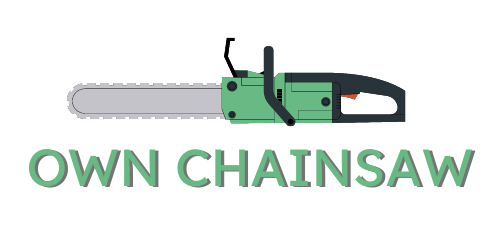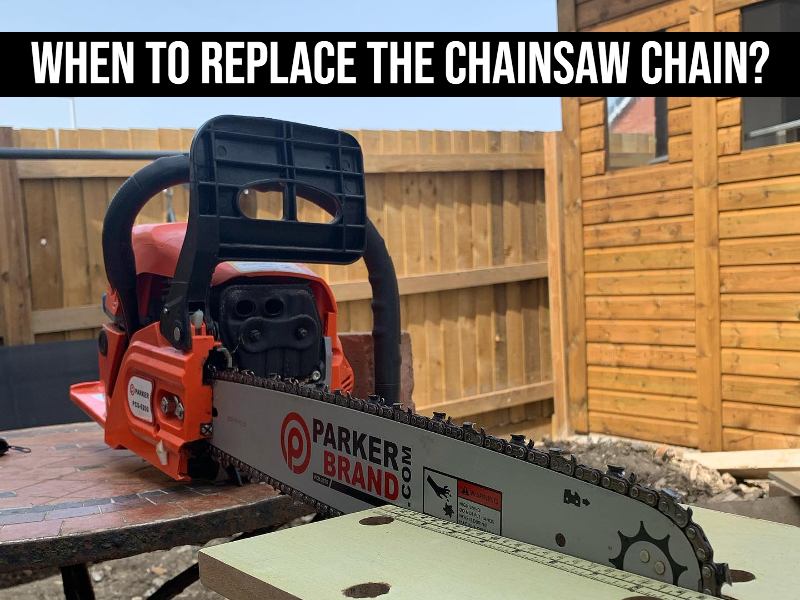
If you’re anything like us, you love the feeling of roaring power as you cut through a thick slab of wood with your trusty chainsaw. But, sadly, even the best-loved chainsaws eventually need a tune-up. One of the most integral parts of keeping your chainsaw in top condition is knowing when to replace the chainsaw chain.
Replacing your chainsaw chain isn’t just about maintaining your chainsaw’s performance – it’s also about staying safe. A worn-out chainsaw chain is more likely to slip off the bar and cause injury.
Here we’ll take a look at how to tell when it’s time to replace your chainsaw chain.
We’ll cover the signs of a worn-out chain, how often to replace it, and even share our favorite tips for extending the life of your chainsaw chain.
How important is a sharp chainsaw chain?
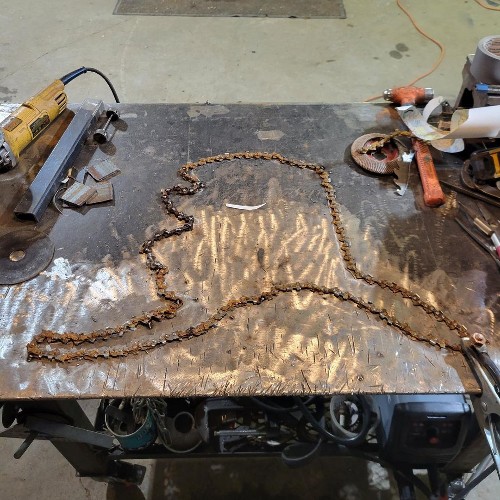
A sharp chainsaw chain is essential for getting the job done safely and efficiently. Because chainsaws are strong equipment, a dull chain can quickly create kickback or bind, which might potentially cause major damage or injury.
When working with larger pieces of wood, a sharp chain also provides a cleaner, smoother cut with the least amount of effort.
Moreover, a sharp chain uses less energy to cut, which means less tiredness and quicker cutting times. Last but not least, keep in mind that a sharp chain is a safer chain and will enable you to do the task swiftly and with little effort.
When to replace the chainsaw chain?
Chainsaw chains need to be replaced when they become worn or damaged. It is important to check for wear and damage regularly to ensure that your chainsaw is running safely and efficiently.
The best way to determine when a chainsaw chain needs to be replaced is to use a wear marker. A wear marker is a metal device that is placed over the chainsaw teeth and moved along the chain.
When the marker reaches the same level as the teeth, it indicates that the chainsaw chain is worn and should be replaced.
Besides checking for wear with a wear marker, it is also important to check for missing teeth or damage to the teeth. If there are any missing teeth or significant damage to the teeth, the chainsaw chain should be replaced immediately to avoid any potential safety hazards.
Chainsaw chains stretch naturally and are not typically a sign that they need to be replaced.
When it comes to replacing the chainsaw chain, there are a few other factors to consider.
1. Pitch
When replacing chainsaws, the pitch is an important consideration. The pitch refers to the distance between the drive links on the chain.
It’s crucial to choose the correct pitch for your chainsaw because if the pitch is off, the chain won’t fit correctly and won’t be able to rotate smoothly.
To determine the pitch of your chainsaw chain, you’ll need to measure the distance between three consecutive drive links and divide that number by two. This will give you the pitch.
It’s important to note that different chainsaw models have different pitch sizes, so you’ll need to ensure you’re choosing the right one for your particular model.
You can find this information in your chainsaw’s manual or by doing a quick online search.
When you use the wrong pitch chain, your chainsaw may perform poorly, reduce efficiency, and even be damaged. Replace your chainsaw chain carefully and choose the correct pitch.
2. Guage
The gauge of a chainsaw chain refers to the thickness of the drive links that fit into the guide bar. Incorrect gauges can cause the chain to not fit properly, resulting in safety issues and damaging your chainsaw.
You can check the specifications of your chainsaw online or consult your owner’s manual to determine the right gauge.
The gauge is often indicated by a number, such as .050 or .063. It is crucial to match this number when purchasing a new chain.
Using a chain with the incorrect gauge can cause the chain to bind or jump off the bar, which can be dangerous. It can also cause excessive wear to the chain and bar, leading to costly repairs or replacements.
3. Link count
Link count refers to the number of links in the chain. Each link is a small metal piece that connects the cutting teeth of the chain.
The link count can vary depending on the size and length of the chainsaw chain. It is important to select a chain with the correct link count to ensure a proper fit and optimal performance.
If you select a chain with too few links, it will not fit properly and may cause damage to your chainsaw.
On the other hand, if you select a chain with too many links, it will not have enough tension and may slip or come off during use.
The number of drive links on the chainsaw chain will give you the link count. You can do this by first removing the chain from the saw and laying it out flat. Then count the number of drive links on the chain.
4. Types of chain
When it comes to replacing the chain on your chainsaw, one important factor to consider is the type of chain you’re using.
Different types of chains are intended for different purposes and have varying levels of durability and performance.
Here are the four main types of chains to consider:
Full chisel Cutters:
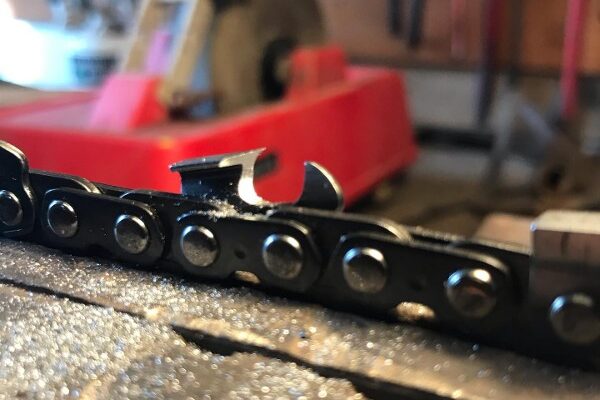
With square-profile teeth, full chisel cutters can cut through trees efficiently and quickly. These chains are designed for chainsaws of a professional caliber and are best suited for demanding tasks like felling large trees or cutting thick logs.
The aggressive nature of these chains may require more maintenance if used for a long period.
Semi-chisel cutters:
The blades of semi-chisel cutters have rounded edges, making them more versatile than full-chisel cutters. Suitable for gardening and yard work, they can be used at any time of year.
Moreover, they do not disintegrate as often as full chisel chains, making them a good choice for those who want a durable, long-lasting chain.
Micro-chisel cutters:
Unlike semi-chisels, micro chisels have tiny, rounded corners on their blades. These chains are ideal for woodworkers who need to make precise cuts and want a chain that will give them the level of control they need.
A full chisel chain might be too aggressive for light- and medium-duty jobs.
Low-profile cutters:
The low-profile cutters also offer little kickback, making them a good choice for beginners who are just beginning to use a chainsaw.
Since they are not as aggressive as other types of chains, they are ideal for routine chores like pruning and cutting small branches.
How to know when the chainsaw is worn out?

If you are a chainsaw user, it is essential to know when it’s time to replace or sharpen the blade. Cutting with a dull blade can be dangerous and put additional strain on the motor and bar of a chainsaw, which is strong equipment.
When assessing whether your chainsaw is worn out, there are various symptoms to watch out for.
The first sign is decreased cutting performance. If you find yourself exerting greater pressure than usual to cut, or the chain is unable to cut as much as it used to, it’s probably time for a new blade.
Another sign is rattling or bouncing when cutting. This is an indication that the chain is dull and needs to be replaced or sharpened.
Your chainsaw pulling in one direction when cutting is another indication. This is a sign that the cutting teeth have dulled on one side, making it uneven. Bars and chains should be sharpened or replaced as soon as possible to prevent uneven wear.
Lastly, if you notice any visible damage to the chain, such as bent or broken cutting teeth, it’s time to replace it. Keeping an eye out for loose chain links is also important, as they can cause an unsafe situation when the chain is moving.
Can sharpening be an alternative to replacing a chainsaw chain?
Sharpening a chainsaw chain is an acceptable alternative to replacing the chain in most cases. A chainsaw chain consists of a series of metal teeth connected by a riveted link.
These teeth can become dull over time, causing the cutting performance of the chainsaw to suffer. To restore the performance of the chain, the teeth must be sharpened.
The sharpening process involves filing the teeth to an angle that will allow them to cut through wood efficiently. The filing should be done at a uniform angle and with the same pressure applied to each tooth.
Care should be taken to avoid filing too aggressively, as this can lead to a weak spot in the chain. The sharpening process should be repeated periodically, as the teeth will become dull again over time.
FAQs:
How do I properly install a new chainsaw chain?
Installing a new chainsaw chain is not a difficult task provided you have the proper tools and equipment. First, make sure the saw is off and unplugged. Then use a screwdriver to remove the existing chain. Once the old chain is removed, use the manufacturer’s instructions to properly install the new chain. Make sure the direction of the chain is correctly aligned and that all the nuts and bolts are properly tightened. Once the chain is installed, start the chainsaw and test it to make sure the chain is running correctly.
How often should I check the chainsaw chain?
Regularly check the chainsaw chain’s condition. It is a good idea to inspect it after every use. You should inspect the chain for signs of wear and tear such as nicks, cracks, and dull spots. Tensioning the chain properly is also important. If it’s too loose, it could cause the saw to vibrate and kick back, resulting in an unsafe condition.
How often should I replace my chainsaw chain?
Generally speaking, chainsaw chains should be replaced every 2-3 years, depending on how often you use them. Additionally, if the chain becomes dull or damaged, it should be replaced as soon as possible.
What can happen if I don’t replace my chainsaw chain?
You risk damaging your chainsaw as well as your material if you don’t replace the chainsaw chain when it is due. A dull or damaged chain can cause the saw to kick back, which can be dangerous. A dull or damaged chain will also not provide a clean, straight cut, so it is not recommended.
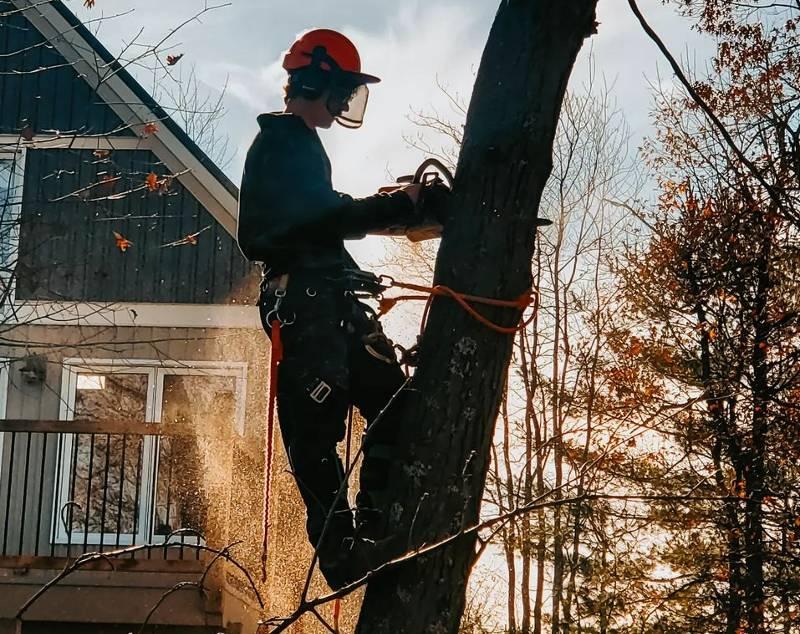
I am Senior Editor and CEO and I have been a chainsaw enthusiast for over 12 years. As a passionate chainsaw enthusiast, I have got a wealth of knowledge and experience with chainsaws, and I am constantly striving to expand my expertise and knowledge. Read More!
